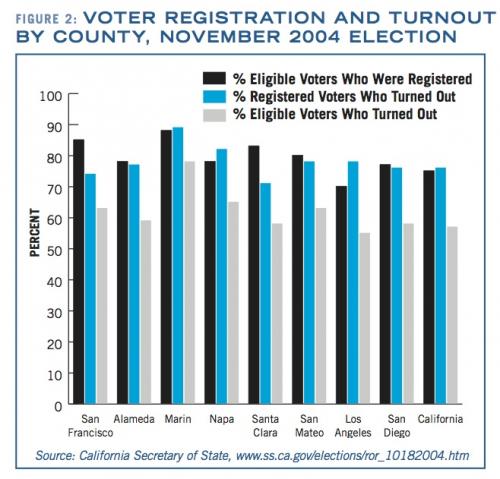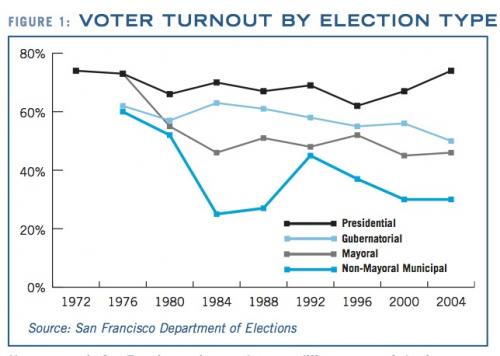San Francisco is by many standards a politically active, civically engaged city. But like almost anywhere else in the nation, voter participation in San Francisco is far from universal. Many of our City officials are elected by about 30 percent of registered voters—and when eligible but unregistered voters are included, that number is even lower. SPUR recently commissioned a research project to analyze voter participation trends, review the literature on the determinants
of voter turnout, and suggest policy alternatives at the local level for boosting voter participation.
Turnout is affected by a wide range of variables, including demographics, policy barriers that limit or encourage participation, community characteristics, and the perceived importance of policy issues at stake, to name just a few. Voter participation rates vary greatly across local governments. One study of California cities finds that turnout for city council elections in California cities ranged from 10 to 89 percent, so clearly local variables come into play.1 But can these variables be affected by local policy, or is there something deeper at work?
One pattern that is clear in San Francisco voter participation is that turnout is much higher for particular types of elections. Over the past 30 years, turnout of registered voters has averaged about 69 percent for presidential elections, 58 percent for gubernatorial elections, 52 percent for mayoral elections, and just 38 percent for non-mayoral municipal elections.
Clearly then, one way that San Francisco could quickly increase the number of people who vote for local offices such as the Board of Supervisors, city attorney, and even mayor would be to shift
the timing of these elections so they coincide with presidential and gubernatorial elections. Of course, while such action may increase turnout, it will be primarily because people vote for these offices because they happen to be at the polls, not because of any meaningful change in our local democracy.
Most discussions of the actions government can take to increase voter turnout concentrate
on reducing barriers to voting. This approach conceives of a potential voter as making a decision about whether to cast a ballot based on the perceived costs and benefits of voting. For example, a person who cares somewhat about an election outcome, but who must take time off work and travel across the city to vote, may decide it isn’t worth it. By reducing the costs associated with voting, previous non-voters on the margin will cast a ballot, increasing turnout. This framework has led to policy changes such as more geographically dispersed polling places, ballot materials printed
in multiple languages, and absentee voting, all of which make it more convenient to cast a ballot. Other barrier-reduction policies in place include state-mandated time off to vote and the federal Motor Voter Act, intended to make voter registration more accessible and convenient.

This figure compares voter turnout levels across California cities. Eligible voters include everyone who has a legal right to vote. However, not all eligible voters actually register to vote, which is necessary to cast a ballot. The most typical measure of voter turnout is the percentage of registered voters who cast a ballot in a given election.
However, many of the traditional policy actions to reduce barriers to voting are either already in place in San Francisco, or are outside the jurisdictions of City government. For example, the City already distributes voting materials in many languages, conducts outreach through the voter pamphlet and other materials, has widely dispersed neighborhood polling places, absentee balloting, and early voting at City Hall. Other barrier reduction strategies, such as same-day registration and expanded polling hours are under the jurisdiction of state government, and cannot be changed locally.
But the strategy of reducing barriers to voting addresses only one side of the equation. A broad range of social forces, having little to do with voting mechanisms and election administration, clearly have a large impact on citizens’ decisions about whether to vote. Researchers are increasingly focusing on the underlying social mechanisms that affect whether people vote. This research focuses on “civic engagement,” which refers
to how much people participate in collective activities such as volunteering, joining community- based and religious organizations, and other activities that are not explicitly political in nature but which establish a sense of connection to and stake in the community. These forms
of apolitical civic engagement, such as joining the local PTA or volunteering at a homeless shelter, have been shown to lead to much higher levels of voter turnout over the long run.

Voter turnout in San Francisco varies greatly across different types of elections. Presidential elections have historically drawn the highest levels of participation, and non-mayoral municipal elections the lowest. December runoff elections, which are no longer necessary since voters approved ranked choice voting in 2002, had even lower turnout levels than non-mayoral municipal November elections.
While the connection between civic engagement and voter participation has been clearly established, it is less clear what concrete policy actions local governments can take to strengthen civic engagement. Some researchers call for a more formalized, higher quality process of public participation over a longer period of time, as opposed to the often superficial, last-minute shouting matches at City Hall that all too often characterize public participation in San Francisco. The San Francisco Better Neighborhoods Program, where planning officials worked closely with community members in planning for major neighborhood change, perhaps most closely resembles this model locally. Other cities have formed “neighborhood councils,” which provide
an opportunity for neighborhood representatives
to become formally engaged and educated over
the long term in local government issues.
While it is still up for debate what policies City government can use to strengthen civic engagement, it is becoming increasingly clear that there are few quick-fix policy options remaining for local governments in California to increase voter turnout. It may be time
to reframe the debate to look at what San Francisco can do to strengthen the social roots of political participation over the long run.
--
Endnotes
1 Hajnal, Zoltan L., Paul G. Lewis, Hugh Louch, “Municipal Elections in California: Turnout, Timing and Competition,” Public Policy Institute of California, 2002.